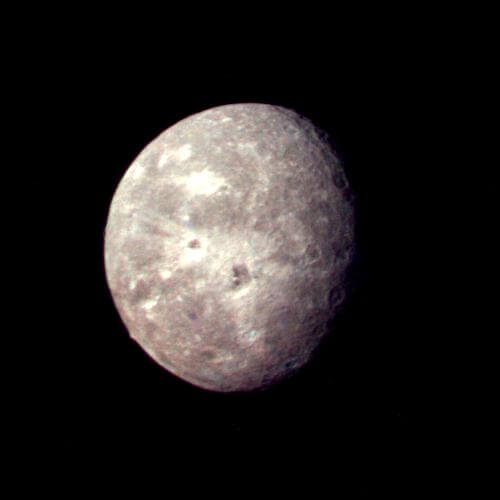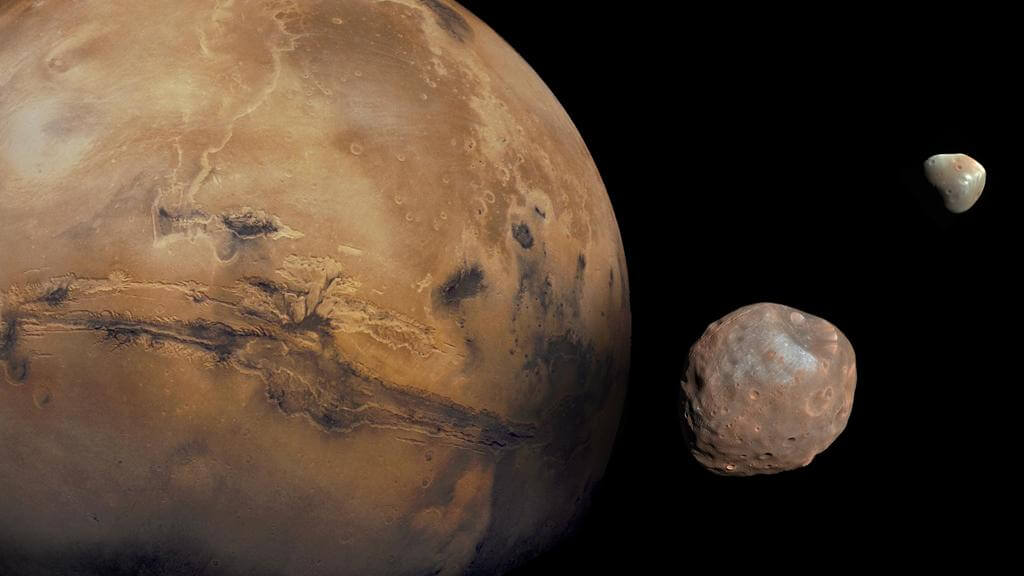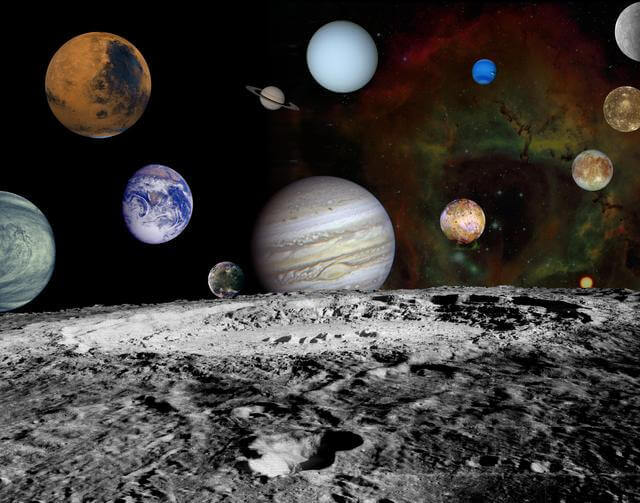Our solar system consists of many celestial bodies, including spherical planets and a large number of natural satellites. Natural satellites, also known as moons, come in many sizes, shapes, and types. They are a lot more than rock balls circling the planets. Moons are generally believed to be formed by the leftover dust and gas during a planet’s formation.
Moons orbit dwarf planets, planets, and other objects present in the solar system. Our solar system has over 200 moons, not including moons that orbit other bodies present in the solar system like asteroids and dwarf planets. It has been noticed that the larger the planet, the greater the chances of moons orbiting it.
The International Astronomical Union (IAU) has the power to name planets and satellites. In the past, moons have been known to get their names from the mythological characters of different cultures. Some moons are also known to get their names from the plays of William Shakespeare or the poetry of Alexander Pope.
Moons of the Outer Planets
Jupiter, Uranus, Saturn, and Neptune are the planets that orbit in the outer part of the solar system. These planets have more moons as compared to the inner planets. The main reason behind this is that the outer region of the solar system is colder due to which water, instead of becoming steam, freezes to ice. This promotes the accretion of ice and the leftover material from the surrounding disk of their planets.
Jupiter
How many moons does Jupiter have? Well, the menagerie of Jupiter consists of the largest moons, also called Galilean Moons, of the solar system, including Ganymede, Europa, Calisto, and Io. It also consists of moons with elliptical orbits and moons that orbit in the opposite direction of their planets. Jupiter has 79 moons, out of which 53 have names, while the others are still awaiting their official names.

- Io is currently the fourth-largest moon in our solar system, slightly larger than the Earth’s moon. It is the most volcanically active moon, with erupting lava, volcanoes, and lakes of molten silicate on its surface. Io’s volcanoes can be viewed from Earth using telescopes that show the volcanoes’ intensity. Io whips around Jupiter at a distance of 484 million miles. Io’s atmosphere is made up of sulfur dioxide and has no rings. Spacecrafts have studied Io and have deduced that life cannot be supported on this moon.
- Callisto is the second-largest moon of Jupiter and the third-largest moon in our solar system. This crater-covered planet has an icy surface and a salty ocean below it. Callisto is locked with Jupiter tidally and orbits it at a distance of 1,170,000 miles. Even though Callisto was known to have a carbon dioxide atmosphere for years, recent studies show that Callisto’s exosphere also has hydrogen and oxygen.
- Europa’s size is 90% the size of the moon of the Earth, with a diameter of 1940 miles. It orbits Jupiter at a distance of about 417,000 miles. It is formed from the leftover material of Jupiter’s condensation. Europa has a rocky mantle, an iron core, and an ocean of salty water. It has an atmosphere of oxygen and also possesses a magnetosphere. Life on Europa is possible as there is water availability and the right chemicals.
- Ganymede is the largest moon in our solar system. It is also bigger than Pluto and Mercury. It has a solid ice and rock surface with an atmosphere of oxygen. Ganymede has a magnetosphere and an underground ocean with more water than Earth. There is also a possibility of life on this moon because of the abundance of water.
Saturn
How many moons does Saturn have? Saturn has 82 moons, which makes it the planet with the largest number of moons. Out of 82 moons, 53 have names, while 29 are still awaiting their official names. The two moons studied the most from Saturn are Titan and Enceladus.
- Titan is the second-largest moon in the solar system. Titan’s same side faces Saturn, and its atmosphere mainly consists of nitrogen. Titan does not have any moon or rings. It has a surface of hard rock, water ice, and an ocean below its surface. It is known that life can exist on Titan’s subsurface ocean.
- Enceladus has a diameter of 313 miles and an orbital period of 32.9 hours. Enceladus sprinkles its ocean into space, resulting in a ring of ice particles in its orbit. This is also the moon that reflects the most sunlight.
Uranus

Uranus has 27 moons, including Ariel, Cordelia, and Juliet. All the moons present in Uranus are named to pay homage to the plays, poems, and characters of William Shakespeare and Alexander Pope. Unlike any other moon, Miranda has eight small satellites, which results in overcrowding and increased chances of collision. The five largest moons of Uranus include Oberon, Titania, Umbriel, Ariel, and Miranda.
Neptune
Neptune has 14 moons, including Despina, Galatea, and Neso. The largest and the most famous Neptune moon is Triton which is currently the coolest object in the solar system with its atmosphere made of nitrogen and methane. It is also volcanically active and contains more rock than Saturn and Uranus.
Moons of the Inner Space
The inner planet moons are natural satellites with circular orbits. The inner strengths and friction of these moons protect them against tidal forces. Inner planets are also known to have lesser moons than outer planets mainly because of the gravitational forces of the Sun.
Mercury and Venus
Mercury and Venus are two planets that do not have any moons due to their small size and proximity to the Sun. Any moon orbiting these two planets would collide with the planet and be destroyed due to strong gravitational forces.
Earth
Earth is the first inner solar system planet with a natural satellite, also the fifth-largest in the solar system. This is the first moon that was discovered, thus its name. It is at a distance of about 240,000 miles from the Earth. Due to impacts from asteroids and comets, the moon’s surface is cratered. This moon was formed due to an impact from another planet, which also impacted Earth’s gravitational field. The presence of the moon helps in moderating the climate of Earth.
Mars
The moons of Mars: Phobos, and Deimos were discovered by Asaph Hall in 1877 and their names can be linked to Roman mythology. Mars’ moons are the smallest in the solar system. These moons can also be used as base moons to launch robots and observe the Red planet. The composition of both moons shows us that these are possible asteroids that have been captured.

- Phobos has a non-spherical shape with a radius of 11.27 km. It is approximately 78 million km away from Earth and 6000 km from Mars and has an orbital period of 8 hours. It is the only moon to orbit so closely around its planet, which results in a strong gravity effect on it from the planet.
- Deimos is the smaller moon of Mars. Its orbital period is 30 hours, and it is at a distance of 48 million miles from its host planet. It has a radius of 6.2 km. The moon has a gravity of 0.003m/s^2, so ejecta escapes into space rather than settling on its surface.
Conclusion
While determining the exact number of moons is not possible, it is known that each planet has anywhere between zero and hundreds of moons. These moons are mysterious but interesting structures with different atmospheres, sizes, shapes, and structures that orbit around their host planet. Astronomers have conducted and are planning missions on different moons to discover if they are suitable for life or not.

